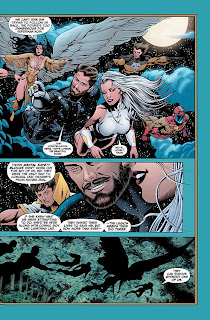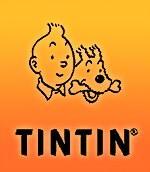Whew! What a term. I hadn’t expected to be away from the blog for so long, but somehow, life just kept interposing itself between my fingers and the keyboard. It feels good to be back though…finally!
And what have I come back to, exactly? What the heck, let’s review.
 A lot has happened over the past several months—much of it highly enjoyable. 52 wrapped up in style thanks to the Oolong island shenanigans, the Morrisonian metamorphosis of Mr. Mind, and the return of the multiverse (hooray!). Hard to say yet whether or not Countdown will be a worthy follow-up given its luke-warm first issue, but the commercial and creative success of 52’s weekly universe-spanning adventure bodes well for those of us who revel in this sort of thing.
A lot has happened over the past several months—much of it highly enjoyable. 52 wrapped up in style thanks to the Oolong island shenanigans, the Morrisonian metamorphosis of Mr. Mind, and the return of the multiverse (hooray!). Hard to say yet whether or not Countdown will be a worthy follow-up given its luke-warm first issue, but the commercial and creative success of 52’s weekly universe-spanning adventure bodes well for those of us who revel in this sort of thing.
Regardless of how Countdown fares (and I’m optimistic about its chances), I’m pleased that DC will be reprinting the Kirby Fourth World material in omnibus format. Though it is perhaps sacrilegious to say so, Kirby’s DC work has always felt like a poor relation to his truly “senses-staggering” work for Marvel—but that may only be because I’ve read so little of the former. Now I’ll have no excuse. Also, the reprinting of the Kirby material does something quite ingenious: it simultaneously showcases another part of DC’s rich history, while at the same time covertly “Marvelizing” that history (in a good, 1960s Marvel way) for readers like me who (ignorantly) associate Kirby primarily with Marvel—all at the very moment that Marvel itself seems to be deemphasizing its own mythic past (eg. Lee/Kirby FF) in favor of a more pedantically “realist” approach to superhero storytelling.
In any event, even though DC’s everything-old-is-new-again approach isn’t for everyone, I at least find the current regime’s dedication to linking newer material more fully to the mythic sensibility of the company’s roots very gratifying. In fact, the very concept of the multiverse—with all the creative chaos that such a model implies—sits perfectly with that mythic sensibility. (Classical myth, after all, presented its interpreters with perhaps the original set of fanboy problems: multiple versions of characters with similar but not identical histories, continuity glitches, etc.). Bring on the contradictions!
Meanwhile, JLA has finally emerged from its six-issue coma (the Geo-Force/Tara Markov teases have me a-tingle), and Geoff Johns and Dale Eaglesham’s dazzling Justice Society of America continues to set the bar for mainstream superhero storytelling.

Of course, these books are also currently hosting the long hoped-for return of the classic (and best) Levitz-Giffen Legion (newsarama’s recent feature on The Great Darkness Saga had me getting all misty the other day). Now that we’ve got ourselves some multiple earths, surely it can’t be too long before we see the classic Legion back in monthly action…I hope!
And what of DC’s trinity? Not a rosy picture, despite several strong starts. Of Detective, Batman, Superman, Action, and Wonder Woman, the only title I’m still buying is Batman—though Morrison’s all-prose issue was almost enough to make it a clean sweep. I’m not a huge fan of the stand-alone stories, so Dini’s Detective was always one of the last books I read on the week it came out; it was good, I suppose, but I don’t particularly miss it. Needless to say, the bungled scheduling of the Super-titles has been frustrating. The main story arcs in both of those books felt like potential classics, but I finally reached the end of my patience with fill-ins and will be waiting for the trades on the Johns/Donner/Kubert saga and Busiek/Pacheco’s Camelot. At least there’s hope for Wonder Woman. Gail Simone, as everyone knows, is not just exceptionally talented. She’s a professional. She’s also a genuine fan with an unusual level of commitment to the books she writes. There is simply no better writer for this series; it’s a shame that it took Didio so long to realize this and that the relaunch had to stumble so badly in the meantime.
Meanwhile, my post-Civil War disenchantment with Marvel continues. One book deserves a mention, however, and that’s Ellis and Deodato’s Thunderbolts. I had my reservations about this one, but I’m completely won over: this book is riveting…and gorgeously drawn. My favorite Marvel title by a fair stretch; the fact that it is a satire of mainstream Marvel doesn’t hurt either.
In the world of superhero cinema, Ghost Rider was mildly entertaining—if you could get over the increasingly cadaverous Nicholas Cage and his distracting collection of hairpieces. A challenge, frankly. Nonetheless, some of the effects were nifty and the scene in the desert where the two riders are side-by-side was a beauty. Speaking of Marvel films, I’m surprisingly enthused about the new Fantastic Four movie this summer, which looks pretty wonderful, actually. Despite its many, many flaws, the goofy first installment of the FF franchise was at least fun to watch, which is more than I can say about a number of recent superhero films. Some time ago, I argued that in order to be truly great, superhero films had to take the characters and the scenarios seriously. I still believe that, but after the guffaw-inducing bathos of Spider-Man 3 (more on that below) I’m really ready for something lighter—you know, like Galactus and the end-times.

Ah, Spider-Man 3. Anthony Lane’s New Yorker review called it “a shambles,” which is generous. After the superb Spider-Man 2, I guess it was inevitable that things would go off the rails at some point, and woooo! did they ever. I don’t want to be merely dismissive of the third film, because it did contain a number of spectacular sequences (the fight scenes between Peter and Harry early in the film were standouts). As a story, though—ugh. Shockingly boring. For the last hour of the movie I must have checked my watch more often than I did for the entire duration of Singer’s bloated Superman. When Mary Jane was finally caught in that giant web all I could feel was relief. Yes! The big battle! We’re almost done! And then the film ended…several times. Apart from its terrible pacing and inconsistent tone, Spider-Man 3 suffered from the same problems (though perhaps not quite as severely) as the egregious X3. In both cases, the filmmakers attempted to cram the plots of two potentially great movies into a single script, leaving us with an underwhelming, narratively flaccid pastiche of characters and ideas. Did we really need Sandman and Harry Osborne and Venom and evil Peter Parker and Gwen Stacey? Apart from a few nice action sequences, the best scene in the film—the most authentic feeling scene—was, ironically, the totally charming, totally throwaway omelette-making bit between Harry and MJ that culminates in Harry accidentally dropping half the omelette on the floor when he tries to get too fancy with the skillet. (There’s a metafilmic metaphor in there somewhere, but why bother?) The point is that this was one of the very few scenes that actually made me for a moment believe in the reality of these characters; compare the emotion of this scene with the histrionics of the conclusion. Was there a single opening weekend theatre-audience that did not greet Peter’s waterworks with gales of laughter? I doubt it. Even I laughed...albeit mirthlessly. I really can’t do better to sum up my feelings about this one than to quote the closing lines of Lane’s review: “‘People really like me,’ our hero says at the start, adding later, ‘They love me!’ Not for long, Whiny-Man, not for long.”
Didn’t mean to leave things on such a crabby note, but there it is. I’m pinning my hopes for summer superhero fun on the Surfer.
 Thomas has a blog! And as you might expect from the author of this dazzling guest-piece on X3 here at Double Articulation, it's home to provocative and erudite pop culture commentary--or maybe it's just a place to stew in his seething hatred of Lost, Season 3. Time will tell! Since I've only seen up to the end of season 2, I can't read this fun-looking piece until December, but angry, angry Thomas has promised some Marvel-bashing, which I await with baited breath. P.S. Thomas's inspired defense of X3 (prompted by a certain blogger's unkind review) lives again in a phenomenal post by the prodigious plok!
Thomas has a blog! And as you might expect from the author of this dazzling guest-piece on X3 here at Double Articulation, it's home to provocative and erudite pop culture commentary--or maybe it's just a place to stew in his seething hatred of Lost, Season 3. Time will tell! Since I've only seen up to the end of season 2, I can't read this fun-looking piece until December, but angry, angry Thomas has promised some Marvel-bashing, which I await with baited breath. P.S. Thomas's inspired defense of X3 (prompted by a certain blogger's unkind review) lives again in a phenomenal post by the prodigious plok! At first I was excited. Then I remembered that I swore I'd never be sucked into seeing another idiotic Spielberg picture. Damn you, Fates! Meanwhile, Anthony Lane has a nice Tintin article in this week's New Yorker in honor of the centenary of Herge's birth. The abstract of Lane's article is available online.
At first I was excited. Then I remembered that I swore I'd never be sucked into seeing another idiotic Spielberg picture. Damn you, Fates! Meanwhile, Anthony Lane has a nice Tintin article in this week's New Yorker in honor of the centenary of Herge's birth. The abstract of Lane's article is available online.












